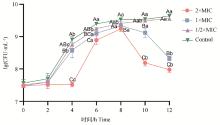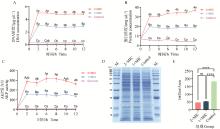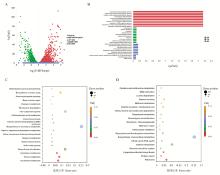





Acta Veterinaria et Zootechnica Sinica ›› 2025, Vol. 56 ›› Issue (5): 2451-2465.doi: 10.11843/j.issn.0366-6964.2025.05.041
• Clinical Veterinary Medicine • Previous Articles Next Articles
LIANG Liwen1,2( ), LI Junxing2, YUAN Xiufang2, YU Bin2, YE Shiyi2, XU Lihua2, SU Fei2,*(
), LI Junxing2, YUAN Xiufang2, YU Bin2, YE Shiyi2, XU Lihua2, SU Fei2,*( ), LIU Canying1,*(
), LIU Canying1,*( )
)
Received:2024-05-15
Online:2025-05-23
Published:2025-05-27
Contact:
SU Fei, LIU Canying
E-mail:331668280@qq.com;sufei6986@outlook.com;liucy3032@163.com
CLC Number:
LIANG Liwen, LI Junxing, YUAN Xiufang, YU Bin, YE Shiyi, XU Lihua, SU Fei, LIU Canying. In vitro Evaluation of the Bacteriostatic Efficacy of Tea Saponins Derived from Camellia oleifera Seeds against a Multidrug-resistant Enterotoxigenic Escherichia coli Strain Isolated from Pigs[J]. Acta Veterinaria et Zootechnica Sinica, 2025, 56(5): 2451-2465.
Table 1
Results of antibiotic susceptibility test"
| 抗生素名称 Antibiotic name | 判定标准(抑菌圈直径/mm) Determination riterion(inhibition zones, mm) | 抑菌圈直径/mm Inhibitory zone diameter | 药物敏感性 Drug susceptibility | ||
| S | I | R | |||
| 头孢噻肟Cefotaxime | ≥26 | 23~25 | ≤22 | 17 | R |
| 头孢噻吩Cefalotin | ≥18 | 15-17 | ≤14 | 12 | R |
| 阿莫西林Amoxicillin | ≥17 | 14~16 | ≤13 | 16 | I |
| 氨苄西林Ampicillin | ≥17 | 14~16 | ≤13 | 17 | S |
| 青霉素Penicillin | ≥17 | 14~16 | ≤13 | 8 | R |
| 庆大霉素Gentamicin | ≥15 | 13~14 | ≤12 | 22 | S |
| 卡那霉素Kanamycin | ≥18 | 14~17 | ≤13 | 6 | R |
| 阿米卡星Amikacin | ≥17 | 15~16 | ≤14 | 18 | S |
| 链霉素Streptomycin | ≥15 | 12~14 | ≤11 | 11 | R |
| 多西环素Doxycycline | ≥14 | 11~13 | ≤10 | 12 | I |
| 红霉素Erythromycin | ≥17 | 11~15 | ≤10 | 10 | R |
| 四环素Tetracycline | ≥15 | 12~14 | ≤11 | 8 | R |
| 甲氧苄啶-磺胺甲噁唑 Sulfamethoxazole-Trimethoprim | ≥16 | 11~15 | ≤10 | 6 | R |
| 环丙沙星Ciprofloxacin | ≥26 | 22~25 | ≤21 | 16 | R |
Table 2
MIC of antibiotics against the ETEC strain"
| 抗生素名称 Antibiotic name | 判定标准[MIC/(μg·mL-1)] Determination riterion(MIC, μg·mL-1) | MIC/(μg·mL-1) | 药物敏感性 Drug susceptibility | ||
| S | I | R | |||
| 氨苄西林Ampicillin | ≤8 | 16 | ≥32 | 2 | S |
| 庆大霉素Gentamicin | ≤4 | 8 | ≥16 | 0.5 | S |
| 四环素Tetracycline | ≤4 | 8 | ≥16 | 32 | R |
| 甲氧氨苄-磺胺甲噁唑 Sulfamethoxazole-Trimethoprim | ≤2/38 | - | ≥4/76 | >32/608 | R |

Fig. 1
The growth curve of the ETEC strain treated with different concentrations of tea saponins The ETEC strain was treated with tea saponins at concentrations of 1/2×MIC, 1×MIC, 2×MIC for 12 h, and the growth curves were determined using plate counting. Different lowercase letters represent significant differences in colony counts between different time points under the same tea saponins concentrations, with P < 0.05. Different uppercase letters indicate significant differences in colony counts following treatment with different concentrations of tea saponins at the same time point, with P < 0.05"


Fig. 4
The bacteriostatic action of tea saponins on the ETEC strain A. The effect of tea saponins on the leakage of nucleic acid from the ETEC strain; B. The effect of tea saponins on the leakage of protein from the ETEC strain; C. The extracellular AKP activity of the ETEC strain under the treatment of tea saponins; D, E. SDS-PAGE analysis of the total protein synthesis in the ETEC strain treated with tea saponins. Different lowercase letters represent significant differences in colony counts between different time points under the same concentrations of tea saponins, with P < 0.05. Different uppercase letters indicate significant differences in colony counts after treatment with different concentrations of tea saponins at the same time point, with P < 0.05; ****. P < 0.000 1; ns. No significant differences"


Fig. 5
Transcriptome analysis of the bacteriostatic effect of tea saponins on multidrug-resistant ETEC A. Volcano plot comparing DEGs between the tea saponins-treated group and the untreated control group; B. Significantly enriched GO terms of DEGs; C. Significantly enriched KEGG pathways of upregulated genes; D. Significantly enriched KEGG pathways of downregulated genes"

| 1 | DUBREUIL J D , ISAACSON R E , SCHIFFERLI D M . Animal enterotoxigenic Escherichia coli[J]. EcoSal Plus, 2016, 7 (1): 10. |
| 2 | ZENG Y , LI R , DONG Y , et al. Dietary supplementation with puerarin improves intestinal function in piglets challenged with Escherichia coli K88[J]. Animals (Basel), 2023, 13 (12): 1908. |
| 3 |
LAIRD T J , ABRAHAM S , JORDAN D , et al. Porcine enterotoxigenic Escherichia coli: Antimicrobial resistance and development of microbial-based alternative control strategies[J]. Vet Microbiol, 2021, 258, 109117.
doi: 10.1016/j.vetmic.2021.109117 |
| 4 | NTAKIYISUMBA E , LEE S , WON G . Evidence-based approaches for determining effective target antigens to develop vaccines against post-weaning diarrhea caused by enterotoxigenic Escherichia coli in pigs: A systematic review and network meta-analysis[J]. Animals (Basel), 2022, 12 (16): 2136. |
| 5 | 吴泽龙. 油茶4种皂素的分离鉴定及其生物活性研究[D]. 长沙: 中南林业科技大学, 2023. |
| HU Z L. Isolation, structural elucidation, and bioactivities of new theasaponins from Camellia Oleifera cake[D]. Changsha: Central South University of Forestry and Technology, 2023. (in Chinese) | |
| 6 |
GUO N , TONG T , REN N , et al. Saponins from seeds of genus Camellia: Phytochemistry and bioactivity[J]. Phytochemistry, 2018, 149, 42- 55.
doi: 10.1016/j.phytochem.2018.02.002 |
| 7 | LI Y , YAN H , ZEESHAN UL HAQ M , et al. Physiological and transcriptional analysis provides insights into tea saponin biosynthesis and regulation in response to SA in Camellia vietnamensis huang[J]. Horticulturae, 2024, 10 (1): 8. |
| 8 | YANG H , CAI R , KONG Z , et al. Teasaponin ameliorates murine colitis by regulating gut microbiota and suppressing the immune system response[J]. Front Med (Lausanne), 2020, 7, 584369. |
| 9 | 赵亚鑫, 赵楠杉, 梁宗锁, 等. 茶皂素的生物活性及应用[J]. 中国粮油学报, 2024, 39 (7): 225- 234. |
| ZHAO Y X , ZHAO N S , LIANG Z S , et al. Biological activity and application of tea saponin[J]. Journal of the Chinese Cereals and Oils Association, 2024, 39 (7): 225- 234. | |
| 10 |
YU Z , WU X , HE J . Study on the antifungal activity and mechanism of tea saponin from Camellia oleifera cake[J]. Eur Food Res Technol, 2022, 248 (3): 783- 795.
doi: 10.1007/s00217-021-03929-1 |
| 11 |
LI Y , SHAN M , LI S , et al. Tea saponin suppresses Candida albicans filamentation by reducing the level of intracellular camp[J]. Ann Transl Med, 2020, 8 (5): 175.
doi: 10.21037/atm.2020.01.124 |
| 12 | 郭海阳, 莫林兰, 谭海生, 等. 茶皂素的美白功效及其抑菌和抗氧化活性研究[J]. 中国粮油学报, 2020, 35 (06): 83- 89. |
| GUO H Y , MO L L , TAN H S , et al. Whitening effect, antibacterial and antioxidant activities of tea saponin[J]. Journal of the Chinese Cereals and Oils Association, 2020, 35 (06): 83- 89. | |
| 13 | 张文婷. 油茶壳中茶皂素的制备及其抑菌活性研究[D]. 海口: 海南大学, 2019. |
| ZHANG W T. Preparation of tea saponin from Camellia Oleifera and its antibacterial activity[D]. Haikou: Hainan University, 2019. (in Chinese) | |
| 14 | SHANG F , WANG H , XUE T . Anti-biofilm effect of tea saponin on a Streptococcus agalactiae strain isolated from bovine mastitis[J]. Animals (Basel), 2020, 10 (9): 1713. |
| 15 | 孙国志, 梁宗锁, 杨东风, 等. 茶皂素对铜绿假单胞菌的抑菌活性及抑菌机制研究[J]. 中国粮油学报, 2024, 39 (8): 175- 183. |
| SUN G Z , LIANG Z S , YANG D F , et al. Study on the bacteriostatic activity and mechanism of inhibition of Pseudomonas aeruginosa by tea saponin[J]. Journal of the Chinese Cereals and Oils Association, 2024, 39 (8): 175- 183. | |
| 16 |
ZHAO Y , SU R , ZHANG W , et al. Antibacterial activity of tea saponin from camellia oleifera shell by novel extraction method[J]. Ind Crop Prod, 2020, 153, 112604.
doi: 10.1016/j.indcrop.2020.112604 |
| 17 | 刘静, 谢朋飞, 蔡延渠. 茶皂素对临床常见致病菌的抗菌活性及作用机制研究[J]. 广东药科大学学报, 2021, 37 (5): 35- 41. |
| LIU J , XIE P F , CAI Y Q . Study on the antibacterial activity and mechanism of tea saponin against common clinical pathogens[J]. Journal of Guangdong Pharmaceutical University, 2021, 37 (5): 35- 41. | |
| 18 | 王承瑞, 刘思思, 易有金, 等. 不同来源皂素对常见食源性致病菌的抑菌效果研究[J]. 食品工业科技, 2022, 43 (3): 120- 127. |
| WANG C R , LIU S S , YI Y J , et al. Study on the antibacterial effects of saponin from different sources on common food-borne pathogens[J]. Science and Technology of Food Industry, 2022, 43 (3): 120- 127. | |
| 19 | 鲍妮娜, 丁富成, 胡巧缘. 油茶籽粕中茶皂素的优化提取及抑菌活性的研究[J]. 天然产物研究与开发, 2018, 30 (01): 127- 133. |
| BAO N N , DING F C , HU Q Y . Extraction and bacteriostasis effect of tea saponin in Oil-tea Camellia seed cake[J]. Nat Prod Res Dev, 2018, 30 (01): 127- 133. | |
| 20 | CLSI. CLSI M100 Performance standards for antimicrobial susceptibility testing[S]. 32nd ed. Wayne: Clinical and Laboratory Standards Institute, 2022. |
| 21 |
ALTAN G , BUDAK F . Investigation of the antibacterial effect of Taraxacum officinale extracts extracted in different solvents on bacteroides fragilis ATCC 25285 standard strain by broth microdilution method[J]. Mikrobiyol Bul, 2024, 58 (1): 63- 70.
doi: 10.5578/mb.20249906 |
| 22 |
DAS D J , BORUAH J L H , FAMHAWITE V , et al. Antibacterial potential of an ethnic probiotic containing food, akhuni/axone and its chemical characterization[J]. Food Chem Adv, 2023, 2, 100221.
doi: 10.1016/j.focha.2023.100221 |
| 23 |
FELIFEL N T , SLIEM M A , KAMEL Z , et al. Antimicrobial photodynamic therapy against Escherichia coli and Staphylococcus aureus using nanoemulsion-encapsulated zinc phthalocyanine[J]. Microorganisms, 2023, 11 (5): 1143.
doi: 10.3390/microorganisms11051143 |
| 24 |
CHEN P , LIU Y , LI C , et al. Antibacterial mechanism of vanillin against Escherichia coli o157: H7[J]. Heliyon, 2023, 9 (9): e19280.
doi: 10.1016/j.heliyon.2023.e19280 |
| 25 |
GUO L , SUN Y , ZHU Y , et al. The antibacterial mechanism of ultrasound in combination with sodium hypochlorite in the control of Escherichia coli[J]. Food Res Int, 2020, 129, 108887.
doi: 10.1016/j.foodres.2019.108887 |
| 26 |
CHEN Y , GAO Y , YUAN M , et al. Anti-candida albicans effects and mechanisms of theasaponin E1 and assamsaponin A[J]. Int J Mol Sci, 2023, 24 (11): 9350.
doi: 10.3390/ijms24119350 |
| 27 |
HE N , WANG P , WANG P , et al. Antibacterial mechanism of chelerythrine isolated from root of Toddalia asiatica (Linn) Lam[J]. BMC Complement Altern Med, 2018, 18 (1): 261.
doi: 10.1186/s12906-018-2317-3 |
| 28 |
ZHANG Y , ZHANG Y , MA R , et al. Antibacterial activity of epigallocatechin gallate (EGCG) against Shigella flexneri[J]. Int J Environ Res Public Health, 2023, 20 (6): 4676.
doi: 10.3390/ijerph20064676 |
| 29 | YANG L , YANG Y , LIU A , et al. Preparation of bispecific igy-scfvs inhibition adherences of enterotoxigenic Escherichia coli (K88 and F18) to porcine IPEC-J2 cell[J]. Int J Mol Sci, 2024, 25 (7): 3638. |
| 30 | 任建鸾, 张鹏, 殷晗杰, 等. 安徽部分地区猪场产肠毒素大肠杆菌的分离鉴定及其生物学特性分析[J]. 畜牧与兽医, 2020, 52 (5): 87- 91. |
| REN J L , ZHANG P , YIN H J , et al. Identification and biological characteristics of ETEC isolates on large-scale pig farms in Anhui Province[J]. Animal Husbandry and Veterinary Medicine, 2020, 52 (5): 87- 91. | |
| 31 | 杨德鸿, 张鹏, 于沛欣, 等. 苏北地区规模化猪场产肠毒素大肠杆菌的分离鉴定及灭活疫苗效果评估[J]. 微生物学报, 2020, 60 (2): 261- 272. |
| YANG D H , ZHANG P , YU P X , et al. Isolation, identification and evaluation of inactivated vaccine of enterotoxigenic Escherichia coli (ETEC) in large-scale pig farms in northern Jiangsu[J]. Acta Microbiologica Sinica, 2020, 60 (2): 261- 272. | |
| 32 | 赵永师, 杜娜, 杜艳. 中草药对多重耐药菌的抑制作用及机制研究进展[J]. 中国感染控制杂志, 2024, 23 (4): 530- 537. |
| ZHAO Y S , DU N , DU Y . Research progress in the inhibitory effect and mechanism of Chinese herbal medicine on multidrug-resistant organism[J]. Chinese Journal of Infection Control, 2024, 23 (4): 530- 537. | |
| 33 | 杨植, 王煜轩, 王之文, 等. 中药防控产肠毒素大肠杆菌感染仔猪腹泻的研究进展[J]. 中国畜牧兽医, 2024, 51 (12): 5507- 5517. |
| YANG Z , WANG Y X , WANG Z W , et al. Research progress on prevention and control of diarrhea of piglets infected with ETEC by traditional Chinese medicine[J]. China Animal Husbandry & Veterinary Medicine, 2024, 51 (12): 5507- 5517. | |
| 34 | ZHU C , ZHANG M , TANG Q , et al. Structure and activity of the Camellia oleifera sapogenin derivatives on growth and biofilm Inhibition of Staphylococcus aureus and Escherichia coli[J]. J Agri Food Chem, 2019, 67 (51): 14143- 14151. |
| 35 | 何荣荣, 谭运寿, 张美虹, 等. 茶皂素对沙门氏菌的抑菌机理及对鸡胸肉的保鲜效果[J]. 热带生物学报, 2019, 10 (4): 360- 366. |
| HE R R , TAN Y S , ZHANG M H , et al. Antibacterial mechanism of tea saponin against Salmonella sp. and its application in chicken breast preservation[J]. Journal of Tropical Biology, 2019, 10 (4): 360- 366. | |
| 36 | 汪宸卉. 大肠杆菌脂多糖对可拉酸合成的调控机制研究[D]. 无锡: 江南大学, 2021. |
| WANG C H. Regulatory mechanism of lipopolysaccharide on colonic acid biosynthesis in Escherichia coli[D]. Wuxi: Jiangnan University, 2021. (in Chinese) | |
| 37 | ARABSKI M , WASIK S , DWORECKI K , et al. Laser interferometric and cultivation methods for measurement of colistin/ampicilin and saponin interactions with smooth and rough of Proteus mirabilis lipopolysaccharides and cells[J]. J Microbiol Methods, 2009, 77 (2): 178- 183. |
| 38 | WITZKY A , TOLLERSON R 2ND , IBBA M . Translational control of antibiotic resistance[J]. Open Biol, 2019, 9 (7): 190051. |
| 39 | TENSON T , MANKIN A . Antibiotics and the ribosome[J]. Mol Microbiol, 2006, 59 (6): 1664- 77. |
| 40 | WILSON D N . Ribosome-targeting antibiotics and mechanisms of bacterial resistance[J]. Nat Rev Microbiol, 2014, 12 (1): 35- 48. |
| 41 | KOHANSKI M A , DWYER D J , COLLINS J J . How antibiotics kill bacteria: From targets to networks[J]. Nat Rev Microbiol, 2010, 8 (6): 423- 435. |
| 42 | LIN J , ZHOU D , STEITZ T A , et al. Ribosome-targeting antibiotics: Modes of action, mechanisms of resistance, and implications for drug design[J]. Annu Rev Biochem, 2018, 87, 451- 478. |
| [1] | QIN Lei, WU Huimin, XU Qiqi, CHEN Wanzhao, WANG Dong, LI Hongbo, XIA Panpan, LIU Zepeng, XIA Lining. Effect of Exogenous Drug-Resistant Salmonella Typhimurium on Intestinal Flora in Healthy Mice [J]. Acta Veterinaria et Zootechnica Sinica, 2023, 54(5): 2158-2169. |
| [2] | GUAN Tao;YU Bing;CHEN Daiwen;HAN Guoquan;HUANG Zhiqing;MAO Xiangbing;ZHENG Ping;MAO Qian. Tandom Expression and Bacteriostatic Activity in vivo of Plectasin [J]. ACTA VETERINARIA ET ZOOTECHNICA SINICA, 2012, 43(4): 620-626. |
| [3] | WANG Chun-mei;HE Qi-gai;CAO Ji-yue . Multidrug Efflux Systems Involved in Resistance to Antibacterial Drugs [J]. ACTA VETERINARIA ET ZOOTECHNICA SINICA, 2011, 42(4): 455-467. |
| Viewed | ||||||
|
Full text |
|
|||||
|
Abstract |
|
|||||